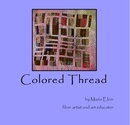So here's a little sneak peak at the behind the scenes of 2 of the shows I'm participating in this month. The second blog post I ever posted on this site back in May of 2009 has the beginnings of this piece:
I worked furiously on it through the summer of 2009 before beginning grad school at Tyler, and I finished all the elements for this image while in a graduate Projects in Fibers course that first semester. It is broken up into a map of the location where I took the source photo. However, grad school took over my life, and I never completed mounting the piece. I pulled it out to accompany the series of cityscapes I'm exhibiting at Nichols Berg Gallery in Chestnut Hill this month in a 4-person exhibit, "Stitch Witchery". I basted all the elements onto a backing of aida cloth, and then did a reverse applique in a rust-colored cotton to superimpose the map grid onto the image. I framed it Sunday to get it off to the gallery for installation. They are also showing my "Brick House" terra cotta and thread pieces and my other large cityscape that is broken up into a map grid as well. Poor art handlers! The opening is this Saturday March 3rd from 6-9.
Much to my dismay, the paint-texture of the wall obscured my delicate pounce marks! Solution? A nice sharp pencil to trace around the pattern, drawing directly on the wall! It was really fun to draw on the wall and see the delicate pattern emerge. Installation took me about 3 hours! The pricked piece is hung in the center with the two pounced and traced patterns on either size. The grand scale and pattern give it a carpet-like feel.
This piece is impossible to photograph! Holes pricked in white paper and thin pencil lines on a cream wall! It can only be appreciated in person. So come on out to B Square gallery this Friday from 6-8.
For more info on Fiber Philadelphia check out all the listings. It's been great to see all my favorite bloggers posting about the biennial- I feel very hyped up about all the events, and it's nice to know I'm not the only one!!
.JPG)
.JPG)





































.JPG)
.JPG)
.JPG)



